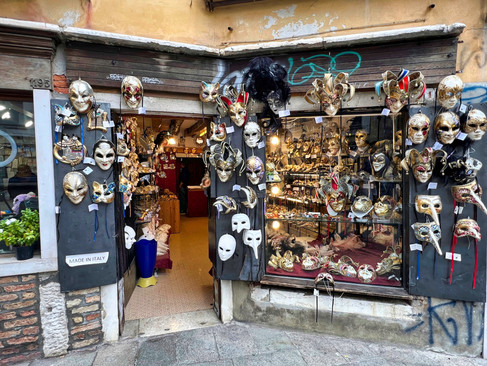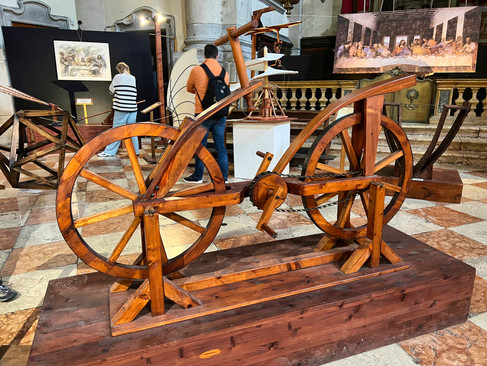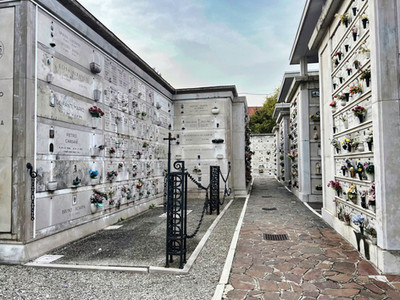As our Dolomites adventure wound down, we were driven back to the Venice airport. There are several ways to get from the airport to the island of Venice. We chose to take the water taxi, which would deliver us directly to St. Mark's Square - the Piazza San Marco - the most famous area of Venice.

It was about a five minute walk/haul (with all our luggage) across plazas and through alleys to our accommodations, the Hotel Montecarlo. It was older and not as nice as our other accommodations in Italy, but it was centrally located and came with breakfast every day. We were booked for five nights (thus, four full days in Venice).
Our first day we decided to explore Venice's main island. We found a route suggested by a blogging couple that had a downloadable Google map. Over 3+ miles and about five hours, we wandered through narrow alleys, broad plazas, along and over canals, through tourist havens like the Rialto Bridge, and finally back to our starting point. Thank goodness for geolocation and walking directions on Google Maps, although in some narrow passages we only had a small view of the sky (and GPS satellites) and would have to wait to the next plaza to be "found" again. We got a really good feel for the variety of different parts of Venice.



Venice is definitely a tourist town, with lots of shops selling trinkets and masks.
The really popular places, like the Piazza San Marco and the Rialto Bridge, are filled with people seeking the perfect Instagram moment.

However, if you walk just 100 yards away from an overcrowded tourist spot, you can find the peace of an empty plaza or alley.
On our second day we rose early to see the Piazza San Marco and the waterfront without tourists as the sun came up. Not only did we enjoy the relative silence but had a good view of the Venetian supply chain - everything on the island is brought in on small boats and then hand-trucked to locations such as stores, restaurants, and hotels.

By the way, everything in Venice happens by boat. It's even how people get to the hospital.

That same day we signed up for a free walking tour with a guide, and explored some lesser known parts of Venice and its history such as the Jewish ghetto.

Venice has many restaurants, and eating outside (al fresco) is very popular. We tried to do that for most of our meals.

As the sun was going down, we got tickets to go up to the top of the campanile, the bell tower of the Duomo (cathedral) for a view of the city and the Piazza San Marco.

While we were up there the bells rang the hour directly over the tops of our heads, loudly!
We devoted our third day to visiting St. Mark's Cathedral, some museums, and the Doge's Palace. You have probably heard about flooding in Venice caused by tides and weather conditions. Although Venice recently completed a multi-billion dollar flood prevention system using floating barriers, they only activate it for major floods. That morning, we got to see some minor flooding in the Piazza, which is the lowest area of the city.

Here is how the local shopkeepers deal with the problem of frequent flooding.

St. Mark's was impressive with its multiple domes. We paid a little extra and got to see the Pala d'Oro, a golden altar piece that is normally hidden from the congregation and only turned around on special occasions.


One interesting thing about the museums was that some featured works from current artists alongside the antiquities.
Leonardo da Vince did not live in Venice, but an old church had been repurposed into a museum featuring wooden models of many of the inventions recorded in his notebooks.
We visited the Doge's Palace as the sun was going down. It was a great example of "excess is best." As part of the tour, we crossed from the Palace to the prison over the famous "Bridge of Sighs," which looks much fancier from the outside than it does from the inside (why provide a treat to the prisoners, after all?).
In the evening, we went to a performance of The Four Seasons, written by Venetian native son Antonio Vivaldi.
On our last full day in Venice, we ventured away from the main island to some of the other 110+ islands in the Venetian lagoon. We first went to Murano, famous for its glass. We made the mistake of signing up for transportation to Murano through our hotel, which provided an exciting ride on a small wooden water taxi through narrow canals, but delivered us to one of the factory showrooms where we got a five-minute glass-blowing demonstration followed by an extensive visit to the gift shop where a dedicated salesperson kept trying to get us to buy some glass.

There was no easy way out of the showroom. If you've ever been to Ikea and tried to find your way to the exit, you'll understand how we felt.
We finally left the factory and then wandered through some empty streets (such a contrast with the main parts of Venice!) and then along Murano's main canal, lined with small shops selling glassware made on the island.

We spent some time at Murano's Museum of Glass, where they have everything from ancient Roman glass to new pieces they're just acquired.

The thing that impressed us the most was the art of millefiori, where tiny glass rods are bundled together into cylinders to make a pattern, which is made even smaller as the cylinder is stretched. Finally, the cylinder is sliced, producing multiple identical pieces. The pieces are tiny but have incredible detail. There were many portraits and even a peacock. Amazing!
We had a seven-day unlimited pass on the vaporetto system (the "bus/subway" system of Venice which operates boats that can take you from Point A to Point B), so we continued on from Murano to the island of Burano, traditionally a home of lace-making and of fishermen. It's famous for its colored houses (Sherwin-Williams would make a killing here). The place was popular with tourists but we managed to find some quieter areas off the beaten path.
While there, we toured the island's Embroidery Museum.
Finally, late in the day, we visited the island of San Michelle, which houses Venice's cemetery. It was, as you might expect, quite peaceful and a good antidote to the busyness of Venice.
We packed our bags the next morning, rolled them out to a vaporetto station, got off at a connection to the bus station to get to the mainland, and arrived with just a three minute walk to the pickup location for our next rental car, which turned out to be another Fiat 500 hybrid. Venice is not very good for accessibility, and a very nice young man offered to help carry our bags down some stairs as we walked to the rental place.
Then it was on to Tuscany and our home location in Siena. More about that in our next post!









































































































We had a very similar experience in Venice and Murano. Really moving along!